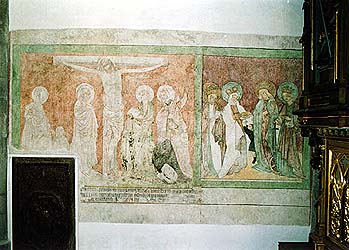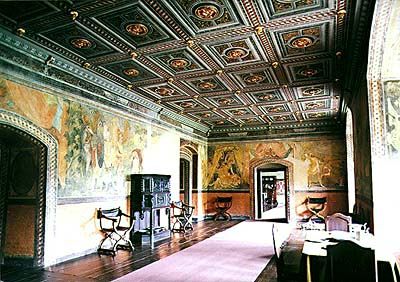History of Painting in Český Krumlov
The development of the art of painting has been an important chapter in the history of painting in Česky Krumlov and has had a close relation to the general historical development of the town. The first mention on Český Krumlov appeared in 1253 and was related to the local castle founded by Krumlov dynasty of the Vitkovci. After their extinction their property was transferred to the Rosenberg dynasty which had been dominating the Czech aristocracy of that period. Consequently, the Rosenbergs created an integral dominion with its center in Český Krumlov, and set up their residential town there. The art was influenced by the town's location close to German and Austrian stimulation and, most of all, by the presence of an important aristocratic dynasty and religious institutions existing in other ancient towns, such as a deanery St. Vitus Church, Minorite and Clarisse Monasteries ( Minorite Monastery in Český Krumlov), petitioners' house and two hospitals of St. Jošt and St. Elisabeth, and, of course, the Castle with St. George's Chapel. Such institutions presented main customers of artifacts determined to decorate church interiors and bring believers to a higher piousness.
No paintings have been preserved from the 14th century period
except for a book painting found in the anthology called Liber
depictus  (The National Library in
Vienna) owned by the Minorites. The anthology which dated back to
1350 described scenes from the Bible and legends about the saints.
Since the book, wall and board painting was in a mutual
relationship as was typical for the Bohemian Gothic painting, it
had a tremendous impact in particular on wall painting. We do not
have much information on the art of painting before 1400 which
could enlighten the relationship of the artifacts imported from
Prague and those of domestic origin. The first painters' workshops
were recorded in town only after the 15th century. Given the fact
that the Rosenbergs had a close relationship with the royal court
in Prague, their requirements on the art works must have been
certainly demanding.
(The National Library in
Vienna) owned by the Minorites. The anthology which dated back to
1350 described scenes from the Bible and legends about the saints.
Since the book, wall and board painting was in a mutual
relationship as was typical for the Bohemian Gothic painting, it
had a tremendous impact in particular on wall painting. We do not
have much information on the art of painting before 1400 which
could enlighten the relationship of the artifacts imported from
Prague and those of domestic origin. The first painters' workshops
were recorded in town only after the 15th century. Given the fact
that the Rosenbergs had a close relationship with the royal court
in Prague, their requirements on the art works must have been
certainly demanding.
The popularity of the cult of the Virgin Mary's and respect to
provincial patrons was very much affected by the court piousness.
This fact, together with the Rosenberg's orientation towards the
royal court, explains the extensive popularity of the "Beauty
style" within the local environment which lasted deeply until the
15th century. An emphasis to the ideal figural beauty, usually lit
up by a mysterious light and wearing a richly folded gown, was
typical for such a of style. The Beauty style was related in
particular to the portrayal of the Virgin Mary which had been
developing in Bohemia from  the end of the 1380's
until the beginning of the following century. The development of
the region during the Hussite wars extended the Beauty style
influence into the regional art of painting. As the head of
Bohemian Catholic aristocracy, Ulrich
II. Von Rosenberg continued in the political and cultural
tradition of the royal court in Prague. In addition to Prague,
Plzeň and partly České Budějovice, Český Krumlov became the center
of the country. Many religious authorities, aristocrats and artists
came to town and participated significantly in its spiritual
profile. This was the very period when the first home painting
workshops began to be active. As opposed to other regions, artifact
requirements were not interrupted by the Hussite movement so
violently here.
the end of the 1380's
until the beginning of the following century. The development of
the region during the Hussite wars extended the Beauty style
influence into the regional art of painting. As the head of
Bohemian Catholic aristocracy, Ulrich
II. Von Rosenberg continued in the political and cultural
tradition of the royal court in Prague. In addition to Prague,
Plzeň and partly České Budějovice, Český Krumlov became the center
of the country. Many religious authorities, aristocrats and artists
came to town and participated significantly in its spiritual
profile. This was the very period when the first home painting
workshops began to be active. As opposed to other regions, artifact
requirements were not interrupted by the Hussite movement so
violently here.
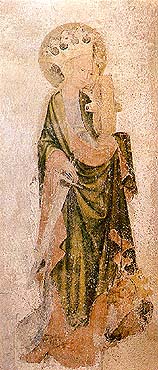 The generous construction
of the St. Vitus Church was launched at the beginning of 15th
century (
St. Vitus Church in Český Krumlov), still before the Hussite
wars burst out. A small painting on the chapel wall above the
northern entrance probably took its origin locally. The very good
quality wall painting from 1410 - 1420 portrayed St. Catherine. The
artifact probably related to the Augustinian Monastery paintings in
Treboň which was founded by the Rosenbergs in the previous century.
A board painting portraying the Madonna with a child featured the
Roudnice-style and was decorated with a wide frame with figural
motives. Its origin was dated supposedly to 1420 and was dedicated
to St. Jošt's Hospital in Prague (National Gallery in Prague). A
further monument of that period of time was a board painting of
Virgin Mary Dolorous from Křížová hora (Museum of History and Art
in Vienna) originally dedicated to St. Vitus Church.
The generous construction
of the St. Vitus Church was launched at the beginning of 15th
century (
St. Vitus Church in Český Krumlov), still before the Hussite
wars burst out. A small painting on the chapel wall above the
northern entrance probably took its origin locally. The very good
quality wall painting from 1410 - 1420 portrayed St. Catherine. The
artifact probably related to the Augustinian Monastery paintings in
Treboň which was founded by the Rosenbergs in the previous century.
A board painting portraying the Madonna with a child featured the
Roudnice-style and was decorated with a wide frame with figural
motives. Its origin was dated supposedly to 1420 and was dedicated
to St. Jošt's Hospital in Prague (National Gallery in Prague). A
further monument of that period of time was a board painting of
Virgin Mary Dolorous from Křížová hora (Museum of History and Art
in Vienna) originally dedicated to St. Vitus Church.
At the end of the 1420's, a local workshop appeared in Ceský Krumlov featuring an anonymous Master of Zátoň altar who had received his name according to the altar in St. John the Baptist church in Zátoň (National Gallery in Prague). Its painted boards show the inner similarity of St. John the Baptist suffering and the passion of Christ. The artist did not rank among the most highly acknowledged art personalities, but his work, which continued Bohemian 15th century board painting, did affect the further development of the domestic painting. His influence can be seen in the house decoration in
 Latrán No. 15, especially in its basement chapel decorated with
a wall painting of Bohemian patrons based upon the style of Karel
IV period. The house was probably occupied by a top religious
dignitary Jan of Lopřetice, an archpriest from Bechyne, who
therefore might have been the customer for those wall paintings.
One of his last masterpieces appeared in the 1440's as a Votive
altar in Přední Výtoň (National Gallery in Prague) featuring the
motive of St. John the Baptist again. Jan Rous of Čeminy, who was
in the Rosenbergs' service, is believed to have donated that altar
decoration. Reininghaus's altar (National Gallery in Prague) with
painted boards portraying Crucifixion and the Saints is also
connected to the Master's work. Even though the altar's quality
is not the best one, it led the way towards the further development
of painting in Český Krumlov. Another of the Master's interesting
connections is with Johann von Rosenberg's prayer book paintings
Latrán No. 15, especially in its basement chapel decorated with
a wall painting of Bohemian patrons based upon the style of Karel
IV period. The house was probably occupied by a top religious
dignitary Jan of Lopřetice, an archpriest from Bechyne, who
therefore might have been the customer for those wall paintings.
One of his last masterpieces appeared in the 1440's as a Votive
altar in Přední Výtoň (National Gallery in Prague) featuring the
motive of St. John the Baptist again. Jan Rous of Čeminy, who was
in the Rosenbergs' service, is believed to have donated that altar
decoration. Reininghaus's altar (National Gallery in Prague) with
painted boards portraying Crucifixion and the Saints is also
connected to the Master's work. Even though the altar's quality
is not the best one, it led the way towards the further development
of painting in Český Krumlov. Another of the Master's interesting
connections is with Johann von Rosenberg's prayer book paintings
 dated to 1450 which
contained five whole-page pictures of the Crucifixion, Christ in
his grave, the Holy Trinity and female saints. The above-mentioned
works even influenced the wall paintings on the northern nave wall
in St. Vitus Church dated to the 1450's. The scene shows the
Crucifixion with Virgin Mary, St. John, St. Mathias and two
donators believed to be Ulrich II. von Rosenberg and his wife.
dated to 1450 which
contained five whole-page pictures of the Crucifixion, Christ in
his grave, the Holy Trinity and female saints. The above-mentioned
works even influenced the wall paintings on the northern nave wall
in St. Vitus Church dated to the 1450's. The scene shows the
Crucifixion with Virgin Mary, St. John, St. Mathias and two
donators believed to be Ulrich II. von Rosenberg and his wife.
The activity of another workshop called Master of the Cross Carrying from Vyšší Brod who created an altar showing Virgin Mary and Christ motives was dedicated to the Monastery in Vyšší Brod culminated during the 1450's. The artist maintained the tradition line of the early 15th century enriched with stimulation from the Austrian school. Unfortunately, schematism and expression emptiness remind us of the period advanced. Two more board paintings related to Český Krumlov were created in that period as well. These were the so-called Schwarzenbergs' visit created for the purpose of Hynek von Švamberk and Lidmila von Rosenberg´s engagement, and a Madonna from the Minorite Monastery (National Gallery in Prague). The board painting of Minorite Madonna took its origin perhaps in relation with the visit of the renowned order preacher Jan Kapistrán in 1451. The painting portrays Madonna of Roudnice-style with a wide picture-decorated frame showing the Order's saints, angels and prophets. Both paintings refer to the retrospective and conservative feature of local art works which turn back to Virgin Mary's motives, and support the portrayal of idealized figures extracted out of their particular environment. What is interesting in this is that the local artists rather did not accept new inspirative stimulation from the nearby Danube region and actually never stepped out of the strong local Beauty style traditions. Both art of sculpture and architecture featured the new late Gothic style, while painting remained oriented towards tradition. A major part of the artwork of that period is anonymous. Only two painters are known from the second half of the 15th century who owned a house in town. Their names were Jindra and Vít.
Several traditional wall paintings were created in Český Krumlov during the second half of the 15th century. Just beside some old paintings, a group of female saints was painted on the St. Vitus Church wall in 1460-1470. This artwork was probably influenced by the board painting style. Remains of paintings portraying The Crucified One and The Assumpta (the Assumption of Virgin Mary) were discovered even in the Prelature building by the church. An unclear piece of wall painting preserved on the house facade in Soukenická No. 35 was dated to the 1470's. Its bottom part portrays St. Bishop and St. Florian, while its upper part shows a horse in the cradle and a disguised figure. The painting probably hides a politically-religious allusion. The importance of Český Krumlov as a center of art began to decrease after 1470. It was caused partly by the Rosenbergs' temporary retreat out of the political and cultural life of the country. The leading position of pinting and sculpture was taken over by the royal town of České Budějovice where the Beauty style and later Gothic traditions from Austrian and Swabian lands outstandingly united.
While the Gothic art of painting focused rather on sacral
motives, Renaissance painting turned rather towards secular themes.
Painting decorations of the 16th century concentrated in particular
to the castle, which had been rebuilt from an ancient  fortress to a
comfortable and ostentatious Renaissance seat, and to the
burghers' houses. Intensions of extensive Renaissance
rearrangements of the Gothic castle in the course of the 1570's
were to represent its owner as a prominent magnate of the Czech
Kingdom, and started out under the penultimate Rosenberg ruler
Wilhelm von Rosenberg (1535-1592), and led by Italian masters.
Simultaneous to the reconstruction arrangements were rich facade
decorations of the castle buildings, third and fourth yard, Little
castle and the tower; interiors of the new representative
Rosenbergs' rooms were decorated with wall paintings as well (see
Renaissance
Reconstructions of Český Krumlov Castle) As opposed to the
previous period of time, the art of painting was inspired rather by
north-Italian art works which corresponded with a general cultural
orientation of the Czech aristocracy often visited by Italian or
Italian art-influenced artists. Several painters, such as Gabriel
de Blonde and Bartoloměj
Beránek-Jelínek, worked for the Rosenberg court of those days.
Gabriel de Blonde, a painter of unknown origin, decorated the
Rosenbergs' rooms with the Old-Testament and mythology themes
evoking Wilhelm von Rosenberg's Catholic orientation and desire of
a son to be born as his heir and dynasty successor. He also
participated in facade decoration of the castle's caretaker
buildings
fortress to a
comfortable and ostentatious Renaissance seat, and to the
burghers' houses. Intensions of extensive Renaissance
rearrangements of the Gothic castle in the course of the 1570's
were to represent its owner as a prominent magnate of the Czech
Kingdom, and started out under the penultimate Rosenberg ruler
Wilhelm von Rosenberg (1535-1592), and led by Italian masters.
Simultaneous to the reconstruction arrangements were rich facade
decorations of the castle buildings, third and fourth yard, Little
castle and the tower; interiors of the new representative
Rosenbergs' rooms were decorated with wall paintings as well (see
Renaissance
Reconstructions of Český Krumlov Castle) As opposed to the
previous period of time, the art of painting was inspired rather by
north-Italian art works which corresponded with a general cultural
orientation of the Czech aristocracy often visited by Italian or
Italian art-influenced artists. Several painters, such as Gabriel
de Blonde and Bartoloměj
Beránek-Jelínek, worked for the Rosenberg court of those days.
Gabriel de Blonde, a painter of unknown origin, decorated the
Rosenbergs' rooms with the Old-Testament and mythology themes
evoking Wilhelm von Rosenberg's Catholic orientation and desire of
a son to be born as his heir and dynasty successor. He also
participated in facade decoration of the castle's caretaker
buildings  (Castle
No. 59 - New Burgrave´s House) from 1578. The chiaroscuro
paintings (painted in various shades of gray) portray
architectonic, ornamental and figural motives from the Bible and
mythology. Nowadays, the paintings are marked with the renovation
effort from the 19th and 20th centuries. Among others, Gabriel de
Blonde took part in the decoration of the 3rd castle courtyard in
1577 (see Wall
Paintings of the III Castle Courtyard in Český Krumlov).
Architecture and figural paintings relating to mythology and Roman
history can be seen on the facades covered with colored sgraffito
(geometrical or other motives scratched into wet parquet).
Decoration of the 4th yard again covered with colored sgraffito was
inspired by The Metamorphosis by Ovidius and The Seven Virtues and
Planets (Wall
Paintings of the IV. Castle Courtyard in Český Krumlov).
(Castle
No. 59 - New Burgrave´s House) from 1578. The chiaroscuro
paintings (painted in various shades of gray) portray
architectonic, ornamental and figural motives from the Bible and
mythology. Nowadays, the paintings are marked with the renovation
effort from the 19th and 20th centuries. Among others, Gabriel de
Blonde took part in the decoration of the 3rd castle courtyard in
1577 (see Wall
Paintings of the III Castle Courtyard in Český Krumlov).
Architecture and figural paintings relating to mythology and Roman
history can be seen on the facades covered with colored sgraffito
(geometrical or other motives scratched into wet parquet).
Decoration of the 4th yard again covered with colored sgraffito was
inspired by The Metamorphosis by Ovidius and The Seven Virtues and
Planets (Wall
Paintings of the IV. Castle Courtyard in Český Krumlov).
It is quite obvious to see here how painting motives turned away from mainly religious motives to mythological and historical ones taken either from the Antique period or from astrology and alchemy.
 Another domestic painter
in the Rosenbergs' service, Bartoloměj Beránek-Jelínek (probably
1565-1625), takes credit for the later painting decoration of the
Little castle and the tower in the 1590's, when architecture and
figural motives prevailed once again (Castle
No. 59 - Little Castle, Castle
No. 59 - Castle Tower). Before he came to Český Krumlov and
bought a house there, he had been working at the Bechyně castle.
Another painter, Max Stolting, who focused on emblem paintings,
gilding and coating with no ambitions to perform his own art works,
lived at the the court during the 1580's. More than anything else,
he was rather a capable craftsman performing common painting works
for the castle. It was typical for the Renaissance period to build
representative dynastic galleries. The Rosenbergs had owned such a
collection as well, however,
Another domestic painter
in the Rosenbergs' service, Bartoloměj Beránek-Jelínek (probably
1565-1625), takes credit for the later painting decoration of the
Little castle and the tower in the 1590's, when architecture and
figural motives prevailed once again (Castle
No. 59 - Little Castle, Castle
No. 59 - Castle Tower). Before he came to Český Krumlov and
bought a house there, he had been working at the Bechyně castle.
Another painter, Max Stolting, who focused on emblem paintings,
gilding and coating with no ambitions to perform his own art works,
lived at the the court during the 1580's. More than anything else,
he was rather a capable craftsman performing common painting works
for the castle. It was typical for the Renaissance period to build
representative dynastic galleries. The Rosenbergs had owned such a
collection as well, however,  Polyxena von Rosenberg née
von Pernstein, a widow of Wilhelm von Rosenberg, carted the major
part of it away to her new residence in Roudnice nad Labem where it
became a part of the famous Lobkowitz collection, nowadays
installed at the Nelahozeves castle.
Polyxena von Rosenberg née
von Pernstein, a widow of Wilhelm von Rosenberg, carted the major
part of it away to her new residence in Roudnice nad Labem where it
became a part of the famous Lobkowitz collection, nowadays
installed at the Nelahozeves castle.
The art of painting did not focus just on the castle but
developed significantly in town; in particular in burghers' houses
decoration determined to satisfy more demanding living standard
requirements. Decoration covered both house facades and front room
interiors which documented the owner´s status and well-being. Not
only residence buildings but both breweries and Jesuit College
facades were covered by various types of sgraffito decoration which
was very popular in that environment. Its origin must be sought in
northern Italy. Very interesting wall paintings are preserved on
the famous Krčín house
Kájovská No. 54, on the square called Na Louži, which belonged
to a Rosenberg regent Jakub Krčín of Jelčany. 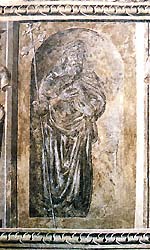 The facade decoration
shows illusive paintings of ornamental, architecture and figural
motives set into horizontal lanes and frames. Pictures of various
people and even a monkey looking out of the painted windows have
been preserved in the upper part of the facade. A burgher house at
Latrán No. 53 features a popular Renaissance motive of Ten
stages of the human life. Another example of rich interior
decoration is in a house at
Náměstí Svornosti No. 14 where wall paintings have been
preserved along the staircase and in two representative rooms on
the first floor. Economic prosperity and cultural stimulation of
the castle under the last Rosenbergs' rule significantly
influenced the appearanceof the town houses. As for the art of
painting, Italian inspirative sources which corresponded with the
general cultural orientation of that period. prevailed in Český
Krumlov. Both foreign and domestic artists influenced by Italian
school were invited.
The facade decoration
shows illusive paintings of ornamental, architecture and figural
motives set into horizontal lanes and frames. Pictures of various
people and even a monkey looking out of the painted windows have
been preserved in the upper part of the facade. A burgher house at
Latrán No. 53 features a popular Renaissance motive of Ten
stages of the human life. Another example of rich interior
decoration is in a house at
Náměstí Svornosti No. 14 where wall paintings have been
preserved along the staircase and in two representative rooms on
the first floor. Economic prosperity and cultural stimulation of
the castle under the last Rosenbergs' rule significantly
influenced the appearanceof the town houses. As for the art of
painting, Italian inspirative sources which corresponded with the
general cultural orientation of that period. prevailed in Český
Krumlov. Both foreign and domestic artists influenced by Italian
school were invited.
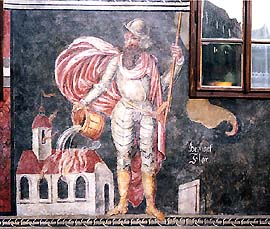
|

|
The Baroque penetrated the local environment in the course of the 17th century and left significant marks upon both the Castle residence and the appearance of the whole town. After twenty years of Emperor Rudolf II. von Habsburg´s administration of Český Krumlov estates sold to him by Peter Wok von Rosenberg in 1602, the Austrian dynasty of the Eggenbergs took over the property. Under the rule of the last Eggenberg, Johann Christian I. (1641-1710) and his educated wife Marie Ernestine von Eggenberg née zu Schwarzenberg who settled down permanently in Česky Krumlov (see Baroque Reconstructions of Český Krumlov Castle), further significant Baroque rearrangements of the castle and religious buildings in town followed.
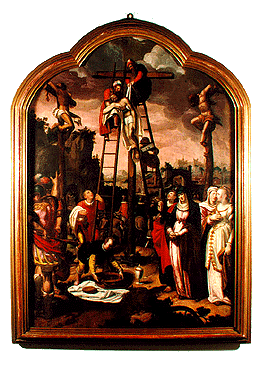 Several painters joined
the court of the prince Johann Christian I. von Eggenberg to
participate in decorating the castle and church interiors in the
town and its outskirts. The majority of them came from Austrian
lands, but their work never really exceeded the average of that
period. The most significant one was Jindřich
de Veerle who came to Český Krumlov from Linz. His work
consisted not only of portraying the princely couple and their
relatives but also of painted maps and scenes for the castle
theater which the couple was very interested in. The first theater
scenes had been previously created by Johann
Martin Schaumberger, a painter from Salzburg, who had built a
theater scene in the so-called Golden Hall in 1675, and which was
later carried over to the new theater building behind the castle
moat. The scene represented a typical Baroque theater decor such as
heaven, hell, the sea, a rocky landscape and others. As was quite
common in those days, Heinrich de Veerle also carried out some
gilding, coating and decoration works and also gave lectures to
talented students. The painter also made altars and hanging
paintings for the Jesuit, Minorite and Clarisse Orders. The general
interest in religion increased significantly during the Baroque
period which was manifested in the period's art of painting.
Several painters joined
the court of the prince Johann Christian I. von Eggenberg to
participate in decorating the castle and church interiors in the
town and its outskirts. The majority of them came from Austrian
lands, but their work never really exceeded the average of that
period. The most significant one was Jindřich
de Veerle who came to Český Krumlov from Linz. His work
consisted not only of portraying the princely couple and their
relatives but also of painted maps and scenes for the castle
theater which the couple was very interested in. The first theater
scenes had been previously created by Johann
Martin Schaumberger, a painter from Salzburg, who had built a
theater scene in the so-called Golden Hall in 1675, and which was
later carried over to the new theater building behind the castle
moat. The scene represented a typical Baroque theater decor such as
heaven, hell, the sea, a rocky landscape and others. As was quite
common in those days, Heinrich de Veerle also carried out some
gilding, coating and decoration works and also gave lectures to
talented students. The painter also made altars and hanging
paintings for the Jesuit, Minorite and Clarisse Orders. The general
interest in religion increased significantly during the Baroque
period which was manifested in the period's art of painting.
Matěj Leutner from Halle in Tyrol was another Eggenberg court painter who worked with mythological motives. A picture of St. Vitus and Virgin Mary Assumption, made for a new early Baroque main altar in St. Vitus Church are his masterpieces. Painters from the Aneis family had often worked at the castle residence; besides the scene and sun dial paintings, however, they focused rather on gilding and coating work. Again, the Aneis' represented rather capable craftsmen than artists. There were many more painters working for the Eggenbergs; however, no significant masterpiece originated during their mostly short-term stays in Český Krumlov.
 In terms of art, Český
Krumlov remained busy even under the Schwarzenbergs' rule who,
after Marie Ernestine von Eggenberg (1719) died, inherited the
whole Eggenbergs' property. The Schwarzenbergs continued the
tradition of employing court painters and built up a gallery of
paintings which served representative purposes. The most
significant painting monuments are associated with the prince
Joseph Adam zu Schwarzenberg (1722-1782) who allowed the later
Viennese Baroque and early Rococo influences settle down in his
residential town. Joseph Adam zu Schwarzenberg, a typical Baroque
aristocrat fostering a busy social life, was very interested in
music, theater and architecture. He took credit for building the
well-known Masquerade
Hall in 1748 which was constructed for social purposes. Its
walls were decorated with illusive paintings by an unknown painter
In terms of art, Český
Krumlov remained busy even under the Schwarzenbergs' rule who,
after Marie Ernestine von Eggenberg (1719) died, inherited the
whole Eggenbergs' property. The Schwarzenbergs continued the
tradition of employing court painters and built up a gallery of
paintings which served representative purposes. The most
significant painting monuments are associated with the prince
Joseph Adam zu Schwarzenberg (1722-1782) who allowed the later
Viennese Baroque and early Rococo influences settle down in his
residential town. Joseph Adam zu Schwarzenberg, a typical Baroque
aristocrat fostering a busy social life, was very interested in
music, theater and architecture. He took credit for building the
well-known Masquerade
Hall in 1748 which was constructed for social purposes. Its
walls were decorated with illusive paintings by an unknown painter
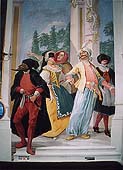 Josef
Lederer called in from Vienna. Such painting belonged to the
Italian wall painting art of the 17th century showing typical
features of vault opening into imaginative heavenly spheres. The
Masquerade Hall paintings replaced utterly the architecture space
decoration. Using illusive paintings, the walls open into a free
landscape and boxes and galleries filled with aristocratic carnival
society. The fictive masquerade ball shows its participants as
aristocrats masked as a Turk, Chinese, forester, soldier, gardener,
and number of Comedy dell'Arte characters. A group of villagers
look curiously through the window at the aristocratic society
enjoying the ball. The painting illusion is even strengthened by
some details such as painted musical instruments laid away,
costumes or the characters bending over out of the painted boxes,
etc. In terms of quality and motive, the Masquerade Hall is
absolutely outstanding within the Czech environment. ¨
Josef
Lederer called in from Vienna. Such painting belonged to the
Italian wall painting art of the 17th century showing typical
features of vault opening into imaginative heavenly spheres. The
Masquerade Hall paintings replaced utterly the architecture space
decoration. Using illusive paintings, the walls open into a free
landscape and boxes and galleries filled with aristocratic carnival
society. The fictive masquerade ball shows its participants as
aristocrats masked as a Turk, Chinese, forester, soldier, gardener,
and number of Comedy dell'Arte characters. A group of villagers
look curiously through the window at the aristocratic society
enjoying the ball. The painting illusion is even strengthened by
some details such as painted musical instruments laid away,
costumes or the characters bending over out of the painted boxes,
etc. In terms of quality and motive, the Masquerade Hall is
absolutely outstanding within the Czech environment. ¨
The Castle Park represented an important space for social life events. Since it was a necessary part of any aristocratic residence, the general rearrangement during 1755 - 1757 involved also a Summer Bellarie Manor remodeling. The painter František Jakub Prokyš (1713-1791) decorated its interiors with fine Rococo paintings. South-German Rococo and French courteous art of painting prevailed in his work which did not focus only on the residential town but appeared even in the surroundings of Český Krumlov. The ceiling paintings in the upper Bellarie hall feature a blue sky with birds flying around and a group of small Cupids with a flower wreath drifting among them. The walls are decorated with vases, flower garlands (a decorative belt from either flowers or fruit) and stucco-like ornaments. An allegory of the Seven Arts featuring Rococo couples playing music, drawing geometry etc. is shown in another room. Arbor vaulting decoration by František Jakub Prokyš shows the Four Seasons motive featuring boys' couples with appropriate seasonal attributes in hands.
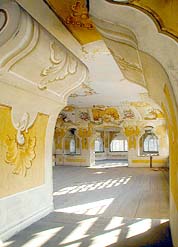
|

|
The building efforts and theatrical preference of the prince Joseph Adam zu Schwarzenberg culminated in the extensive reconstruction of the castle theater finished by 1766 (Castle Theater in Český Krumlov). Viennese painters Hans Wetschl and Leo Märkl decorated the walls with paintings, theater scenes and even participated in the Golden Hall decoration. Both artists were directly influenced by Giuseppe Galli-Bibiena who was the most significant and most sought-after scene designer of that period. They depicted flower and musical still-life pictures with painted, stucco-like frames on the audience walls. The ceiling decoration features the victory of the Muse over ignorance. The stage decoration smoothly melts into the front stage painting in order to create an illusive space where the audience coincides with the stage and spectator's impression is even further strengthened. In addition, Jan Wetschel and Leo Markl created the curtain showing a celebration of the Seven Arts; theater scenes of a military camp, port, forest, burgher's room and study come from their workshop as well. Even ahead of the theatre in Sweden's Drottningholm, in terms of quality and level of preservation, the Castle Theater in Český Krumlov represents a European unique object of its kind.
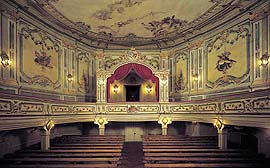
|
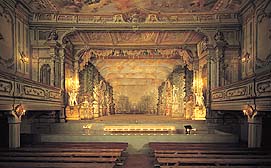
|
The 18th century art of painting focused in particular on religious institutions; however, it also applied to Baroque rearrangements of house facades. Numerous pictures of Virgin Mary or popular saints representing Baroque piousness appeared stucco-framed on the facades. The Prelature building was reconstructed out in 1769 ( Horní No. 155), František Jakub Prokyš decorated its main hall with his typical fine Rococo paintings. He also decorated the Resurrection Chapel near the St. Vitus Church in 1777. The chapel wall-paintings represent typical altar architecture. A little later on, in 1781, V. Tschopper, another Rococo painter, created a wall painting featuring a St. Vitus legend scene was created on the southern presbytery wall. This painter also decorated St. Wolfgang's Chapel in the Minorite Monastery with motives from the legend of St. Wolfgang. Baroque and Rococo art of painting in Český Krumlov, which was inspired in particular by the castle environment around the prince Joseph Adam zu Schwarzenberg and which culminated in the decoration of the Masquerade Hall and Baroque castle theater, concluded with the above-mentioned art works. During the following century, the Schwarzenbergs became attracted rather by the castle in Hluboká nad Vltavou where the whole family ultimately moved. Artistic activities including painting lost its intensity and began to consequently decline. Besides this, the Schwarzenbergs of that period focused rather on economic activities; their artistic ambitions thus retreated.

|

|
Two more court painters appeared in Český Krumlov in the 19th
century, Ferdinand Runk and Charles Louis Philippot. Ferdinand
Runk (1764-1834), a landscape painter, graduated from the
Viennese academy. He focused particularly on watercolors portraying
various places throughout the Schwarzenbergs' estates. Ferdinand
Runk used to teach painting to princess Pauline zu Schwarzenberg
who applied herself to create vedutas (landscape views). The other
court painter,  Charles
Louis Philippot (1839-1859), was of French origin; he had been
working in Linz before the prince Johann Adolf zu Schwarzenberg
called him in. Over the course of his long-term stay in Český
Krumlov, he devoted himself to the copying and restoration of older
paintings and created his own original masterpieces. He was
responsible for the Castle
Gallery containing a collection of not only originals but
copies of Dutch and other painters' masterpieces of the 17th -
19th centuries. He created numerous portraits of the Schwarzenberg
family and burghers, and was considered a respectful court artist.
As the burghers' influence increased, the 19th century represented
the golden age of the burgher portrait which, according to the
aristocratic pattern, served for family representation. In addition
to portraits, Charles Louis Philippot decorated altars dedicated to
the castle chapel (the painting of Virgin Mary on the main altar),
St. Vitus Church (St. Johann Nepomuk in the same church) and
numerous church altars within the region. By the end of the 19th
century no significant masterpiece appeared in Český Krumlov. New
average-quality paintings or overpaintings were usually ordered by
religious institutions such as the St. Vitus Church and the
Minorite Monastery. Inspirative unification of the art of painting
in the castle and town came to its end in the course of the 19th
century.
Charles
Louis Philippot (1839-1859), was of French origin; he had been
working in Linz before the prince Johann Adolf zu Schwarzenberg
called him in. Over the course of his long-term stay in Český
Krumlov, he devoted himself to the copying and restoration of older
paintings and created his own original masterpieces. He was
responsible for the Castle
Gallery containing a collection of not only originals but
copies of Dutch and other painters' masterpieces of the 17th -
19th centuries. He created numerous portraits of the Schwarzenberg
family and burghers, and was considered a respectful court artist.
As the burghers' influence increased, the 19th century represented
the golden age of the burgher portrait which, according to the
aristocratic pattern, served for family representation. In addition
to portraits, Charles Louis Philippot decorated altars dedicated to
the castle chapel (the painting of Virgin Mary on the main altar),
St. Vitus Church (St. Johann Nepomuk in the same church) and
numerous church altars within the region. By the end of the 19th
century no significant masterpiece appeared in Český Krumlov. New
average-quality paintings or overpaintings were usually ordered by
religious institutions such as the St. Vitus Church and the
Minorite Monastery. Inspirative unification of the art of painting
in the castle and town came to its end in the course of the 19th
century.
 Art works in Český Krumlov
including the art of painting was influenced by the fact that it
was a residential town of significant dynasties of the Rosenbergs,
Eggenbergs and Schwarzenbergs. It was just the residence
environment of the castle which stimulated the town with cultural
inspirations often affected by foreign works (Austrian, German,
Italian). Artists working for both the court and town affected the
quality of local art production. Hundreds of years of continuity of
the residential seat was interrupted only after the Schwarzenbergs
moved into the castle in Hluboká nad Vltavou.
Art works in Český Krumlov
including the art of painting was influenced by the fact that it
was a residential town of significant dynasties of the Rosenbergs,
Eggenbergs and Schwarzenbergs. It was just the residence
environment of the castle which stimulated the town with cultural
inspirations often affected by foreign works (Austrian, German,
Italian). Artists working for both the court and town affected the
quality of local art production. Hundreds of years of continuity of
the residential seat was interrupted only after the Schwarzenbergs
moved into the castle in Hluboká nad Vltavou.
(zp)
Further information:
- Painters in Český Krumlov
- Iconography of Český Krumlov
- History of Painting in the Český Krumlov Region



